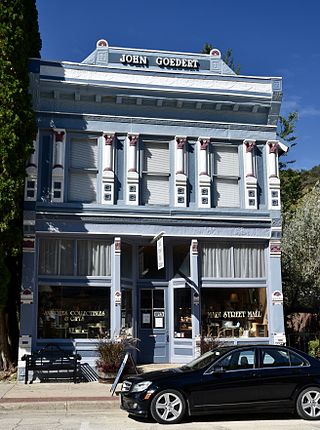
In livestock agriculture and the meat industry, a slaughterhouse, also called an abattoir, is a facility where livestock animals are slaughtered to provide food. Slaughterhouses supply meat, which then becomes the responsibility of a meat-packing facility.

Medora is a city in Billings County, North Dakota, United States. The only incorporated place in Billings County, it is also the county seat. Much of the surrounding area is part of either Little Missouri National Grassland or Theodore Roosevelt National Park. The population was 121 at the 2020 census. It is part of the Dickinson Micropolitan Statistical Area.

The meat-packing industry handles the slaughtering, processing, packaging, and distribution of meat from animals such as cattle, pigs, sheep and other livestock. Poultry is generally not included. This greater part of the entire meat industry is primarily focused on producing meat for human consumption, but it also yields a variety of by-products including hides, dried blood, protein meals such as meat & bone meal, and, through the process of rendering, fats.
Arbogast & Bastian was the name of a slaughterhouse and meat packing plant located in Allentown, Pennsylvania. Once a national leader in hog slaughtering, the company had the capacity to process most of the 850,000 hogs raised annually in Pennsylvania for slaughtering. In its heyday, Arbogast & Bastian slaughtered an average of 4,000 hogs daily.

Antoine-Amédée-Marie-Vincent Manca Amat de Vallombrosa, Marquis de Morès et de Montemaggiore, commonly known as the Marquis de Morès, was a French duelist, frontier ranchman in the Badlands of Dakota Territory during the final years of the American Old West era, a railroad pioneer in Vietnam, and a politician in his native France.

The Nokota horse is a feral and semi-feral horse breed located in the badlands of southwestern North Dakota in the United States. The breed developed in the 19th century from foundation bloodstock consisting of ranch-bred horses produced from the horses of local Native Americans mixed with Spanish horses, Thoroughbreds, harness horses and related breeds. The Nokota was almost wiped out during the early 20th century when ranchers, in cooperation with state and federal agencies, worked together to reduce competition for livestock grazing. However, when Theodore Roosevelt National Park was created in the 1940s, a few bands were inadvertently trapped inside, and thus were preserved.

Medora de Vallombrosa, Marquise de Morès, was an American heiress who married the Marquis de Mores.

The Chateau de Mores in Medora, North Dakota, United States, is a historic home built by the Marquis de Mores in 1883 as a hunting lodge and summer home for his family and guests. The home is now part of the 128-acre (0.52 km2) Chateau de Mores State Historic Site, which also includes Chimney Park and de Mores Memorial Park.

The Union Stockyards of Omaha, Nebraska, were founded in 1883 in South Omaha by the Union Stock Yards Company of Omaha. A fierce rival of Chicago's Union Stock Yards, the Omaha Union Stockyards were third in the United States for production by 1890. In 1947 they were second to Chicago in the world. Omaha overtook Chicago as the nation's largest livestock market and meat packing industry center in 1955, a title which it held onto until 1971. The 116-year-old institution closed in 1999. The Livestock Exchange Building was listed on the National Register of Historic Places in 1999.

The Sanitary Laundry Company Building is a historic building located at Baltimore, Maryland, United States. It is a five-bay wide, five-story brick loft building constructed in 1883. The façade features a cast-iron storefront at street level and the elaborate decorative brickwork and terra cotta ornamentation on the upper floors reflect the influence of the Queen Anne style. It was built originally as a slaughterhouse and meat packing plant until 1897, when it was converted to a commercial laundry.

The Maltese Cross Cabin is a cabin used by Theodore Roosevelt, before he was President. The cabin is currently located at the visitor center at Theodore Roosevelt National Park, just outside the town of Medora, North Dakota.

The Elkhorn Ranch was established by Theodore Roosevelt on the banks of the Little Missouri River 35 miles north of Medora, North Dakota in the summer of 1884. Roosevelt hired Bill Sewall and Wilmot Dow, two Maine woodsmen, to run the ranch. Sewall and Dow built the ranch house, "a long, low house of logs," in the winter of 1884–1885.

The Von Hoffman House at Broadway and 5th St. in Medora, North Dakota was built in 1884. It was listed on the National Register of Historic Places in 1977. The listing included one contributing building and one contributing structure.

Peaceful Valley Ranch is about 3 miles (4.8 km) from the town of Medora, North Dakota in the South Unit of Theodore Roosevelt National Park, in western North Dakota. The ranch dates from 1885, when Benjamin Lamb bought the land and built its first buildings. After operating as a ranch, primarily raising horses, the ranch was developed by the Olsen family as a dude ranch before it was acquired by the National Park Service, and incorporated into the Roosevelt Recreation Demonstration Area, which eventually became the present national park. The ranch forms the core of the national park's South Unit. It overlooks the Little Missouri River, in the Little Missouri badlands.

The St. Mary's Catholic Church in Medora, North Dakota was built in 1884 by Peter Book, a builder who also constructed the Von Hoffman House. It was listed on the National Register of Historic Places in 1977.

Initial Rock, also known as Name Rock, in the Medora Ranger District of the Little Missouri National Grassland, near Medora, North Dakota, was listed on the National Register of Historic Places (NRHP) in 1976. It was the site of an overnight camp on May 28, 1876 of George Armstrong Custer's men, on their way to the Battle of Little Big Horn, which happened on June 25, 1876. The NRHP listing included one contributing site and one contributing object on 9.9 acres (4.0 ha).

The Goedert Meat Market, also known as the Main Street Mall, is a historic building located in McGregor, Iowa, United States. The two-story, single-unit, brick building was completed in 1890 in the Italianate style. It maintains the only complete cast-iron storefront in town. The storefront was manufactured by Mesker Bros. Front Builders of St. Louis, Missouri. The facility dates from the time when all aspects of the meat business from slaughter, to processing, to sales were housed in one building. The New York–style meat market was built for John Goedert, who maintained his residence upstairs. By the turn of the 20th-century it housed Bergman's deli/butcher shop, and remained a butcher shop until 1944. The building was individually listed on the National Register of Historic Places (NRHP) in 1996. In 2002 it was listed as a contributing property in the McGregor Commercial Historic District.
The De Mores Memorial Park in Medora, North Dakota was listed on the National Register of Historic Places in 2019.
Albert Henry Kuhn was a Washington State pioneer and businessman. During his early career, Kuhn tried a variety of jobs, moving from state to state until he settled in Washington in 1884 and entered the logging business, where he remained for the rest of his career. He began as a logging foreman, but gained recognition in business circles over time. Eighteen years later, he was one of the founders of a new logging venture: Hoquiam Lumber and Shingle Company. In 1917, he became the manager and biggest shareholder of the Hoquiam shingle mill.




















